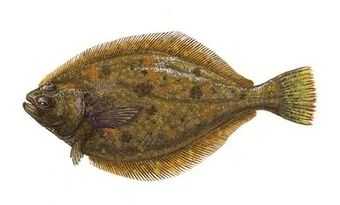Pacific Sanddab

Species Details
Citharichthys Sordidus
Paralichthyidae
Pleuronectiformes
nearshore, offshore, sandy, muddy
1 - 2 lbs.
5" - 16"
Pacific Sanddab (Citharichthys sordidus) Fish Description
The Pacific Sanddab (Citharichthys sordidus) is a type of flatfish that is left-eyed—meaning, both its eyes are situated on the left side of its body. Like all flatfishes, it is an opportunistic predator and a master of camouflage not just because it can lie flat on its side on sea beds, it also has the uncanny ability to change its color and patterns to match its surroundings. With that, it spends most of its life right on the seafloor, partially hidden and waiting for unsuspecting victims to swim by.
The Pacific Sanddab has an oval body that is colored dull brown with blotches of dark brown or black on the top “eyed” side. The underside, on the other hand, is usually off-white or tan. The top part sometimes may also feature some white or orange spots. Another way of telling it apart from other flatfishes is its straight mid-line, which is typically slightly curved in other flatfishes.
Spawning season usually starts in July and ends in September, spawning several times during these months. The females are known to produce numerous eggs every season and the eggs are fertilized externally.
The Pacific Sanddab is targeted by both commercial fishers and recreational anglers because of its meat that is often described as lean and firm and it has a nutty sweet taste. This tasty fish is often deboned and filleted but the skin is usually left on as it’s known to have a rather savory taste—often compared to French fries. It can also be cooked in several ways.
Diet and Size
Although the Pacific Sanddab may reach sixteen inches in length and two pounds in weight, most that are caught are just under a pound. Unlike other flatfishes that are observed to be sluggish swimmers, the Pacific Sanddab can actually swim much faster and are said to be pretty agile.
The Pacific Sanddab is a carnivorous fish and prey on pretty much any moving creature that may cross their path, which includes a wide array of small crustaceans, small fishes, mollusks, squids, and even octopuses.
Pacific Sanddab Interesting Facts
- The Pacific Sanddab can grow up to sixteen inches in length and up to two pounds in weight.
- Their average lifespan tends to be between nine to ten years.
- Females live longer and are often much bigger than males.
- They are masters of camouflage and opportunistic predators.
- They can change their color and markings to match their surroundings on command.
- They mostly feed on small crustaceans but may also eat small fishes, mollusks, squids, and octopuses.
- There are more than seven hundred species of flatfishes in the world with the Pacific Sanddab being the largest of the sanddabs.
- They’re regarded as a delicacy in some parts of California.
- They’re often sold frozen, filleted, and deboned.
Fishing Tips
The Pacific Sanddab can be caught all year round, although they tend to move to deeper parts of the ocean during winters. You can use light to medium tackle paired with a small hook (size 6 or 8) to fit the fish’s small mouth. Also, the Pacific Sanddab is not known to be a picky eater so you can pretty much use any bait you have with you. Just make sure your bait is smelly as the fish hunts by scent. Strip fish or squid has been proven to be most effective.
Pacific Sanddab Habitat and Distribution
As the name suggests, this fish is endemic in the Pacific Ocean, more specifically along the coasts of Japan and the eastern Pacific from the Bering Sea to Baja California, Mexico. They are said to be most abundant off the state of California.
As bottom dwellers, you can often find this fish on the seafloor in sandy and/or muddy areas at depths between thirty to more than a thousand feet. However, juveniles can be found mostly in shallower waters.







